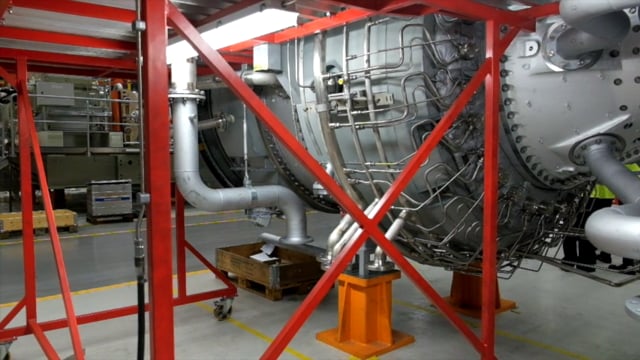[WATCH] Swedish rotors that will power Malta
Construction of a single SGT-800 model takes about 50 weeks, and each turbine is taken through various stages of heavy testing


The Siemens manufacturing compound in Finspong looks ‘abandoned’. Utter silence, clinical cleanliness and total organisation of tools and parts does give little away about the over 64 state-of-the-art turbines manufactured at this facility, annually.
This is the facility where three SGT-800 gas turbines ordered by the ElectroGas consortium for Malta’s new gas operated power station are being built.
Siemens forms part of the consortium together with SOCAR, the Azerbaijani state oil company, and entrepreneurs GEM (Gasan-Fenech) Holdings who will be constructing the LNG plant and providing the natural gas and selling it on to Enemalta for the next decade and a half.
Walking strictly within the grey walkway, Siemens’s sales manager for small power plants Mats Flenhagen is taking a Maltese press contingent through the factory’s safety measures.
Employees here must have a minimum of eight years’ experience before being granted the option of working on the assembly of one of five different models of gas turbines.
Today the Swedish giant, second only to aircraft manufacture Saab in the Swedish manufacturing sector, has a staff complement of 2,800 coming from 35 nationalities (none Maltese). Engineers constitute half the workforce, with 400 of them employed in R&D.
Construction of a single SGT-800 model takes about 50 weeks, and each turbine is taken through various stages of heavy testing. “Testing at our facility is vital as problems found once the turbine is on-site can cost up to ten times more to rectify,” Flenhagen says. Every single turbine incorporates over 26,100 parts.
The metal used for turbine construction comes from northern Swedish metal foundries, where once at the Siemens facility the metal is hardened and turned into metal discs. An €8 million machine, one of only five worldwide, hones the metal discs into rotor discs. Turbine discs take 10 hours to be completed, compressor discs three hours – the final product weighing 900kg.
Individual state-of-the-art hot gas path-blades, constructed through 3D ‘laser drilling’, are then individually hand-mounted into the rotors. A single turbine rotor blade generates power equivalent to a Formula 1 engine. “You can see each blade glowing as it spins,” says product owner Mats Bjorkman.
“Since 1972 not a single blade was ever returned or reported cracked,” Bjorkman proudly explains of the ceramic coating applied on each blade to protect them.
Once constructed the rotors are placed in a vacuum chamber and undergo electron beam welding, a process that softens the metal facets of each part and moulds the different segments into one finished unit, adding strength and reliability to the product. The constructed rotor is then lowered into a chamber seven metres underground for balancing.
A 400-tonne lid seals the chamber. The rotor is spun at 1,000rpm and gradually raised to 100% spinning power. Small, hand-sawn bolts are attached to different sections of the rotor to balance it. Flenhagen says that without the lid, a blade that gets detached from the rotor – spinning at 6,600rpm – would go through the compound’s roof and travel up to 8km before falling to the ground.
Once ready, the rotor is transported up the mountainside 2km away to another facility. When built in the 1970s, only the mountain provided the only ground strong enough to take the weight of the nuclear power plants built at the time. Today the company uses this facility for finalising the assembly of the turbine cores.
‘Green with envy’
Siemens has sold 270 units of its SGT-800 gas turbine since 1998, clocking over 3.3 million fleet hours of operation. Over the past five years, the fleet has reached 99.4% reliability. “The average time between forced outages is of just 5,306 hours, a figure that makes the competition glow green with envy,” Bjorkman says.
The SGT-800 gas turbine is also ‘fuel flexible’, meaning different gases can be used to power the unit. These include methane, nitrogen, hydrogen, carbon dioxide and other fuels.
These turbines can be operated at 50% output without affecting efficiency and emissions, however to ensure maximum lifespan it should be used continuously. “Like all gas turbines, the SGT-800 enjoys spinning. The life span of such units is technically 25 years but with regular maintenance in most cases this is extended to more operational years,” Mats Flenhagen said.
Siemens will be remotely monitoring the turbines operating in Malta. “This saves time and money and eliminates the need of SIEMENS engineers being flown to Malta. Updates, diagnoses and certain maintenance can also be done remotely from Sweden,” Bjorkman says.
Whilst the three turbines destined for Malta are relatively all at the final stages, the company runs the manufacturing process of its units at a week’s interval from each other. This is a contingency plan so if testing reveals an issue with one unit, measures are taken to rectify the same problem before the other units reach the same stage.
Malta’s three SGT-800 destined will ship from Norrköping by the end of November. “The shipping process is one of the most worrying stages, but our vast experience helps,” Flenhagen says.








.jpg)




.jpg)






.png)


